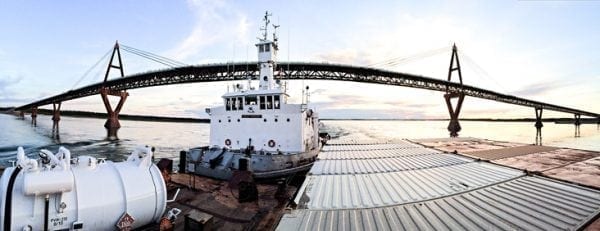A columnist and transportation researcher based in Ontario thinks the country is missing out on considerable shipping potential in the Mackenzie River and Beaufort Sea.
Writing for the Maritime Executive, Harry Valentine has looked into several aspects of Northern shipping potential over the past four years. Most recently, he proposed that a grain terminal on the Beaufort Sea could be a cost-effective way to tackle a current grain backlog and get more of Canada’s product to overseas markets.

“I just publish it as a future possibility,” says Valentine, who studied mechanical engineering and with a focus on transportation at Carleton University, and has been researching Canada’s transportation industry for the past two decades.
“Right now you've got, um, the federal government threatening to issue fines on the railways for not moving enough grain to the West Coast ports ... if things really get serious, if you know, if it cannot move enough to the rocky mountains through to those Pacific ports, there's an option up North.”
While the Northern Transportation Company operated barges along the Mackenzie and into the Beaufort Sea but wound down and finally went bankrupt in 2016, Valentine says the current situation invites a re-examination of the potential.
Earlier this month, 90 per cent of grain silos across Canada were sitting full. Spikes in demand for shipping grain, oil, lumber and ore have put considerable strain on Canada’s two railways, Canadian National and Canadian Pacific.
Valentine says that if demand keeps up, resources won’t get to port in a timely manner unless the railways lay down extra tracks – as currently the routes are just single-tracks – or unless shippers consider other opportunities, like going North.
One option he has floated is using the existing rail tracks to Hay River, now that Canada’s export market is again high and then to ferry resources down the Mackenzie River to the Beaufort Sea and ship from there.
Another idea is to connect Lake Athabasca to Great Slave Lake using navigation locks, which are devices that raise and lower boats between stretches of water.
He says a precedent for how much traffic could be seen on the Mackenzie River has already been set on the Mississippi River in the U.S.
“A railway hopper car will carry about 4,000 cubic feet of grain whereas a single barge on the Mississippi system, these things can carry over 120,000 cubic feet of grain,” says Valentine, adding the barges are often strung together there three abreast by five lengthwise.
He says there could be economic opportunities for floating storage near Tuktoyaktuk, if Canada shipped on the Mackenzie.
While that option might be expensive to get off the ground, Valentine says the economics could be there if the shipping route is used to its full potential.